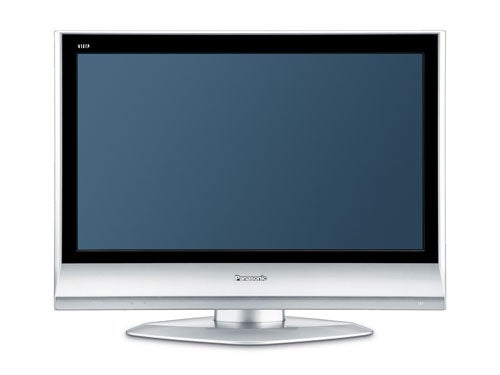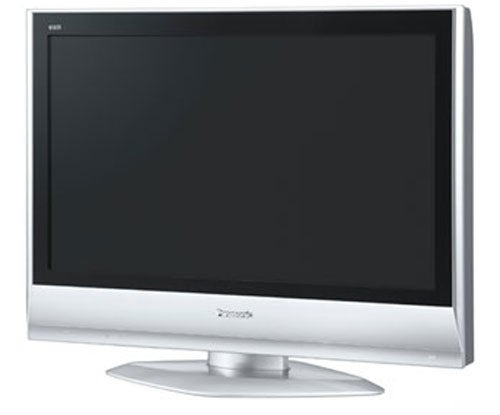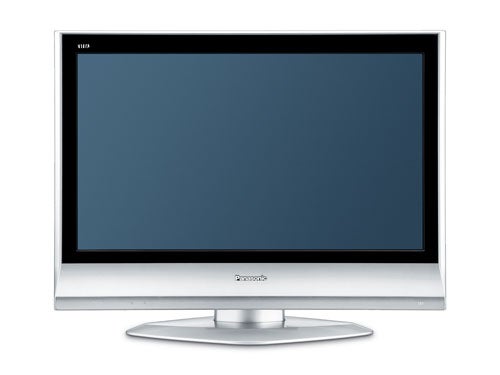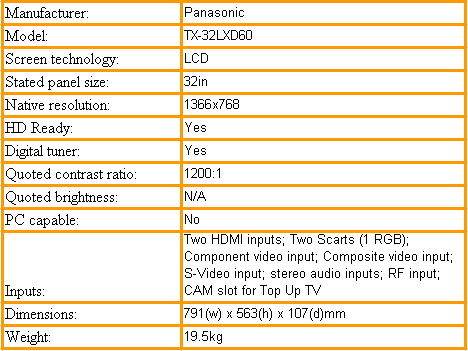Panasonic TX-32LXD60 32in LCD TV Review
Panasonic TX-32LXD60 32in LCD TV
It's a shame that Panasonic won't build large LCD TVs, because this 32in is a good one.

Verdict
Key Specifications
- Review Price: £1300.00
In some ways Panasonic is in a tricky position right now. Why? Because it’s one of only a small handful of companies which not only have feet in both the LCD and plasma camps, but are also still strongly committed to the old argument that while LCD is fine up to 32in, plasma is the only technology that’s good for anything bigger.
The problem with this argument now that big LCDs are getting cheaper and better on a seeming daily basis is that it almost seems to imply a lack of confidence from Panasonic in its own LCD technology. After all, the likes of LG and Samsung are just as happy making 40-46in LCDs as they are 42in plasmas, leaving it up to the public to decide which technology they want to buy.
So Panasonic’s decision to be so vocal about its very deliberate LCD/plasma size division can’t help but appear suspicious. Of course, the best way for Panasonic to lay these suspicions to rest is to deliver a really top-quality LCD TV – and that’s precisely what it hopes to do with the new 32in TX-32LXD60.

The set gets off to a slightly unpromising start, however. Previous Panny LCDs have boasted some quite dramatic styling, but this one’s plain silver, rather flimsy bodywork just comes over as rather bland.
Things look up considerably when it comes to connectivity, with the discovery of not one but two HDMI sockets. These HDMIs are no ordinary HDMIs either, for it turns out they’re also configured to support Panasonic’s new HDAVI system. This is a ‘home network’ system Panny has developed that allows HDMI cables to carry two-way control signals between compatible pieces of equipment. For instance, you could use HDAVI to let your TV control a connected and HDAVI compatible Panasonic DVD recorder.
There was once a time when the AV industry assured us it was working together to make this sort of inter-kit communication global, so that different brands of kit could talk with each other. But surprise surprise, this cracking idea seems to have fallen by the wayside somewhere, meaning HDAVI will only work between Panasonic-branded equipment.
Anyway, getting back to the 32LXD60’s other connections, we also find a set of component video jacks, and a CI slot. This latter jack reveals the presence of a built-in digital TV tuner, as it’s there for adding a conditional access module for subscription digital services like Top Up TV.
It’s not all good news on the connections front, however, since conspicuous by its absence is any form of PC connection – hardly ideal on a 32in LCD TV that’s actually slightly more expensive than most. There are only two SCARTs as well, when we’d always prefer three.
The first proper signs that Panasonic really doesn’t see LCD as a second class TV citizen can be seen in the extravagant amounts of new technology that have been poured into making the 32LXD60’s pictures better. Essentially the set boasts a whole raft of new picture improvements, subsumed under the tongue-twisting coverall title of ‘V-Real Advanced LCD AI’.

Heading things up is Active Light Control, which continually manipulates the LCD backlight so that its output always best suits the content of the picture. So for a dark scene, the backlight intensity would be reduced to increase contrast. This helps the 32LXD60 achieve a very respectable (by LCD standards) claimed contrast ratio of 1200:1.
Talking of contrast, an Active Contrast Control element in the new picture engine uses processing to boost the picture’s luminance output, resulting, it’s claimed, in more subtle details for light and dark picture sections alike. This processing component is also intelligent, in that it calculates when to work its magic on bright parts of the picture alone, without unnecessarily ‘bothering’ darker parts.
Next there’s a Digital Remastering circuit that further increases the screen’s contrast range as well as expanding the set’s colour response – a colour response which is itself further enhanced by a new Advanced Colour Management system for boosting the dynamic range of the red, green and blue picture elements. Finally, Panasonic’s Overdrive processing aims to reduce motion blurring by suppressing ‘after images’ and making colour transitions faster.
This all sounds pretty darned impressive on paper – but does it translate into tip-top picture quality? Indeed it does.
The various processing tricks targeted at colour pay particular dividends, as the Panasonic serves up some of the most vivid colours seen in the LCD world to date. This vibrancy isn’t achieved at the expense of a natural tone, though, with the vast majority of hues looking completely authentic.
The 32LXD60 also enjoys some unusually deep black levels, ensuring that the rich colours have the perfect dark platform to shine out against. This additionally helps the picture look emphatically solid and three dimensional – especially as the Panny’s dark bits are natural and unforced enough to contain the sort of subtle shading details that stop them looking like mere empty black holes.

If you want fine details and sharpness, then the 32LXD60 can give you that too – and what’s more, it can do so without generating the sort of grain or dot crawl noise that sometimes accompanies sharp images.
Finally in the plus column is this Panny’s flexibility. Many LCD TVs look great with HD but struggle with standard definition, whereas the 32LXD60 manages to look impressive with pretty much anything you care to chuck at it.
Keeping the 32LXD60 from a perfect 10 for its pictures are two smallish points. First, motion looks a touch jerky at times. And second, the colour tone occasionally loses its way during dark scenes.
The 32LXD60’s sound is a little disappointing after the success of the pictures, falling prey to the classic LCD weaknesses of insufficient bass and raw power. This means the soundstage is nothing like as involving as the pictures.
”’Verdict”’
We understand Panasonic’s argument that LCD should top out at 32in, we really do. But we have to say that if the 32LXD60’s picture quality is anything to go by, we’d welcome a bigger Panny LCD with open arms. Especially if Panasonic also did the decent thing and added some form of PC connection to it…

How we test televisions
We test every TV we review thoroughly over an extended period of time. We use industry standard tests to compare features properly. We’ll always tell you what we find. We never, ever, accept money to review a product.
Trusted Score
Score in detail
-
Value 8
-
Image Quality 9
-
Sound Quality 6

